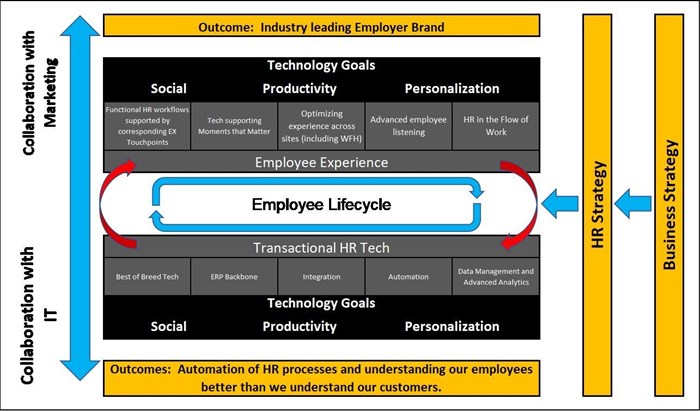Building the Ultimate HR Tech Stack - part 3
Introduction
The second article in this series discussed the ‘transactional HR’ tech group within the Ultimate HR Tech Stack. In this article we will unpack the second group – the ‘Employee Experience’ tech group.
Group 2: Employee Experience Tech
Even though the foundation of your HR Tech Stack needs to be settled first via transactional HR tech, you don’t have to wait for full maturity to start building your employee experience (EX) tech capabilities. In fact, the type of systems and tools used under EX tech is an extension of the work you have done in improving the employee experience via your transactional HR tech.
Outcomes
In the new workplace, attracting and retaining talent has become even more important than ever. Organisations have to provide an employee-friendly workplace where the work of every employee is seamless, enjoyable and inspirational.
The outcome of having the right tech in place to boost the employee experience, is achieving an industry leading employer brand. Having a brand that the talent marketplace recognises as a desirable is invaluable and have enormous benefits.
Categories of tech included
The EX group of tech includes 5 of the 12 HR Tech categories. These categories are:
- Well-being management
- Engagement & culture, employee listening
- Diversity, inclusion and transparency
- Workplace productivity tools
- Analytics & planning
The 5 focus areas of employee experience tech
As mentioned before, the focus areas of each group represent your tactical approach and will ultimately dictate how your HR tech will function. How well you plan and execute your tactics under the following five focus areas will determine the success of your EX tech.
- Functional HR workflows supported by corresponding EX touchpoints: Every HR process has its own workflow that governs its operational execution. And every workflow has touchpoints where a person (HR or employee) needs to perform an administrative or operational task (eg. completing a training attendance register). The technology you utilize must make each touchpoint as seamless as possible.
- Tech supporting moments that matter: There are certain moments as an employee that stand out in their importance. Your first day at work. Your employment anniversary. A promotion. All of these moments need to be supported by technology that not just assist with a seamless workflow, but also with the emotional support needed within these moments.
- Optimising experience across sites (including WFH): Employees experience work differently, depending on where they work. Therefore, a one-size-fits-all technology strategy will not provide an optimal workplace for everyone. You need to deploy the right tech to personalise the employee experience.
- Advanced employee listening: Technology has made it easier to listen to our employees. Whether we employ active listening tools (surveys) or passive listening tools (organisational network analysis), when we understand our employees better, we can create a better work environment.
- HR in the flow of work: Employees should not break their normal work patterns just to interact with HR tech. If your HR systems and tools require employees to remember several different URLs, usernames and passwords and get basic user training on all these systems, they will either not use them or they will decrease their productivity (or both). HR must employ advanced UX principles that allows employees to interact with all their HR tools in the flow of their normal work.
Interdepartmental collaboration: HR working with marketing
Over the past few years, the emphasis on employer branding brought the HR and marketing departments closer together. However, when HR builds the employee experience side of the HR tech stack, their relationship with marketing will grow stronger. As your EX maturity grows, HR will employ traditional marketing specialists into their team including UX/UI, branding and digital marketing.
Conclusion
For years, organisations neglected investment in their HR tech and got away with it. The slow march towards a tech-driven workplace (4IR) wasn’t enough to incentivise investment. It took a global shock (Covid-related lockdowns) and its accompanied jump towards a new workplace to jolt organisations into action. Those organisations who diligently invested in their HR tech prior to the lockdowns are now reaping the benefit of an efficient HR function that is fully digitised and automated, and that is providing a seamless, productive and inspirational employee experience driven by tech. For most organisations though, the lockdown served as a wake-up call regarding the importance of HR tech for sustainable future growth.
Building the Ultimate HR Tech Stack has never been as important as it is today.




























